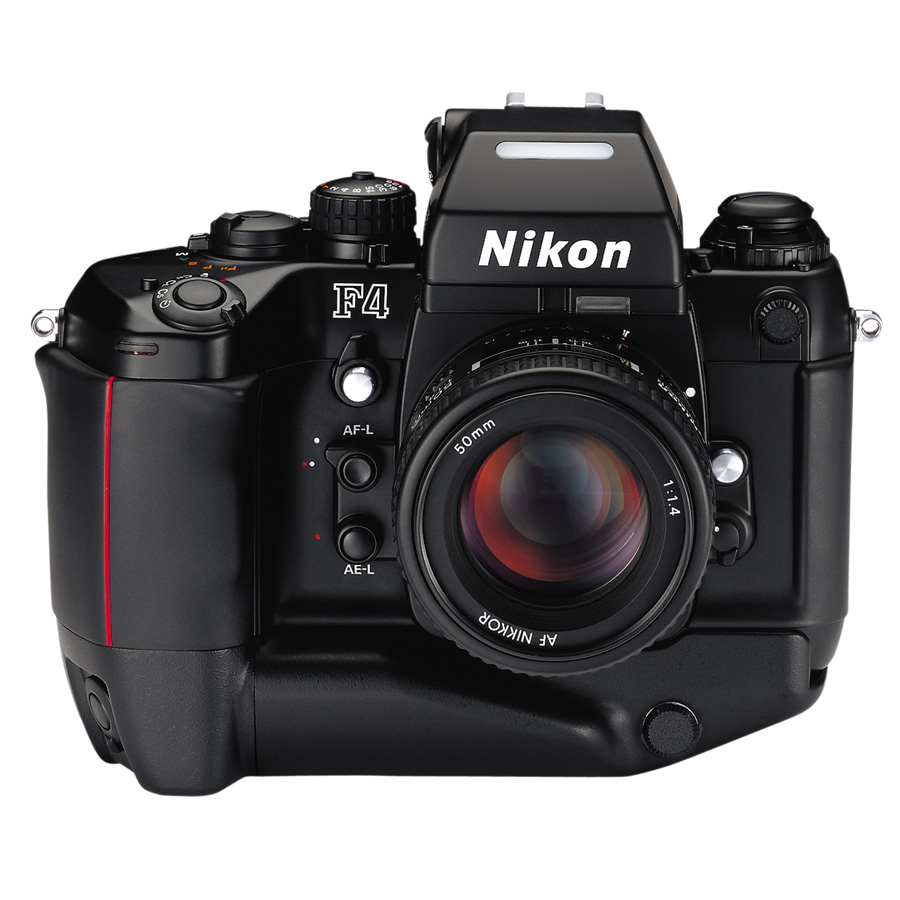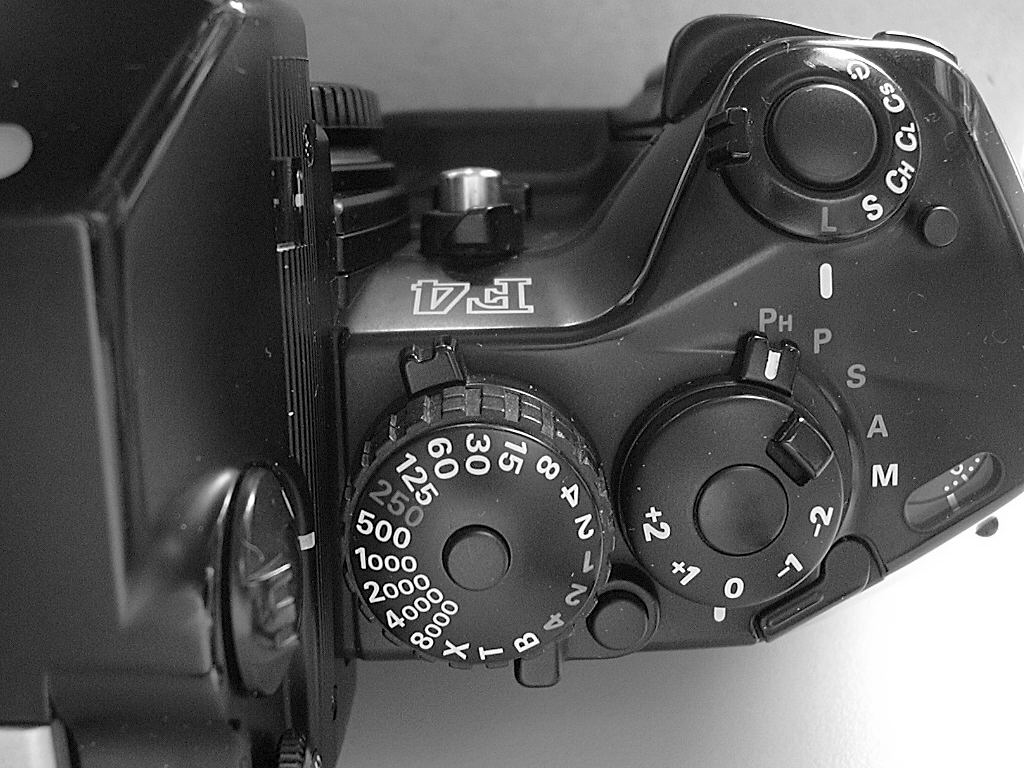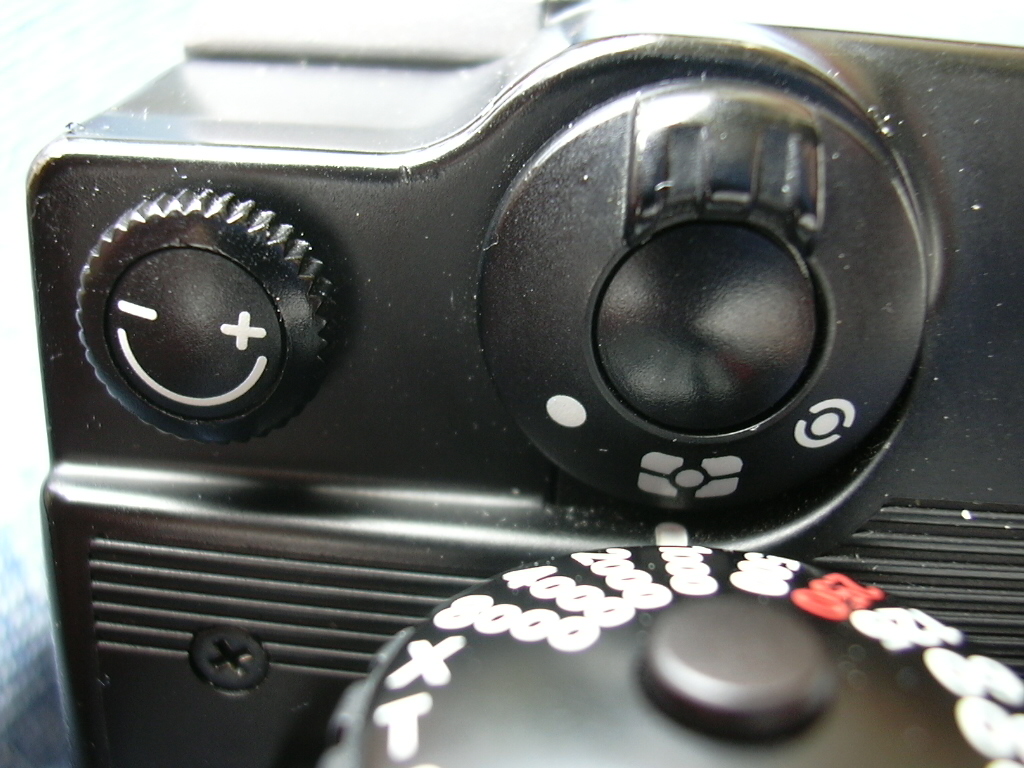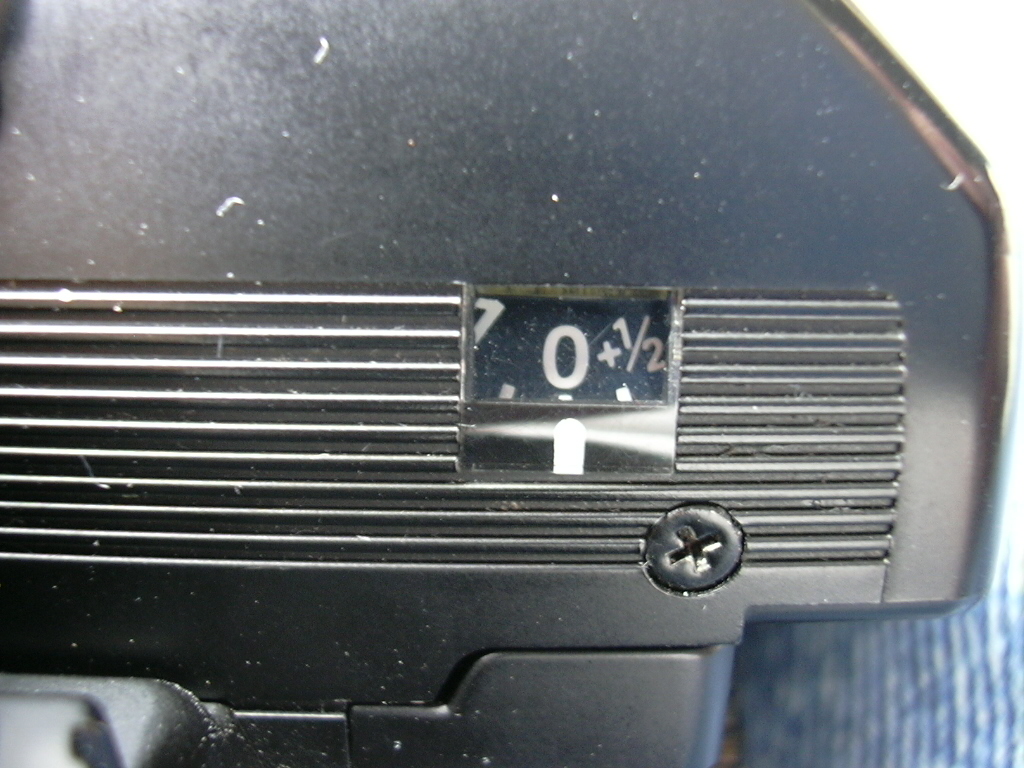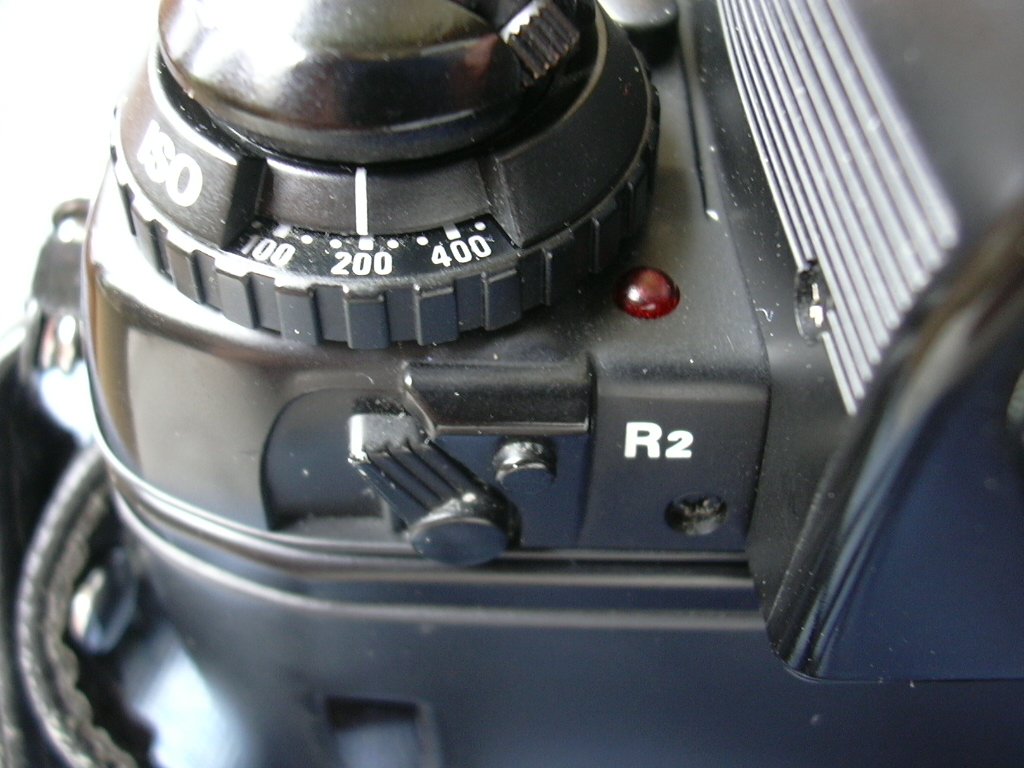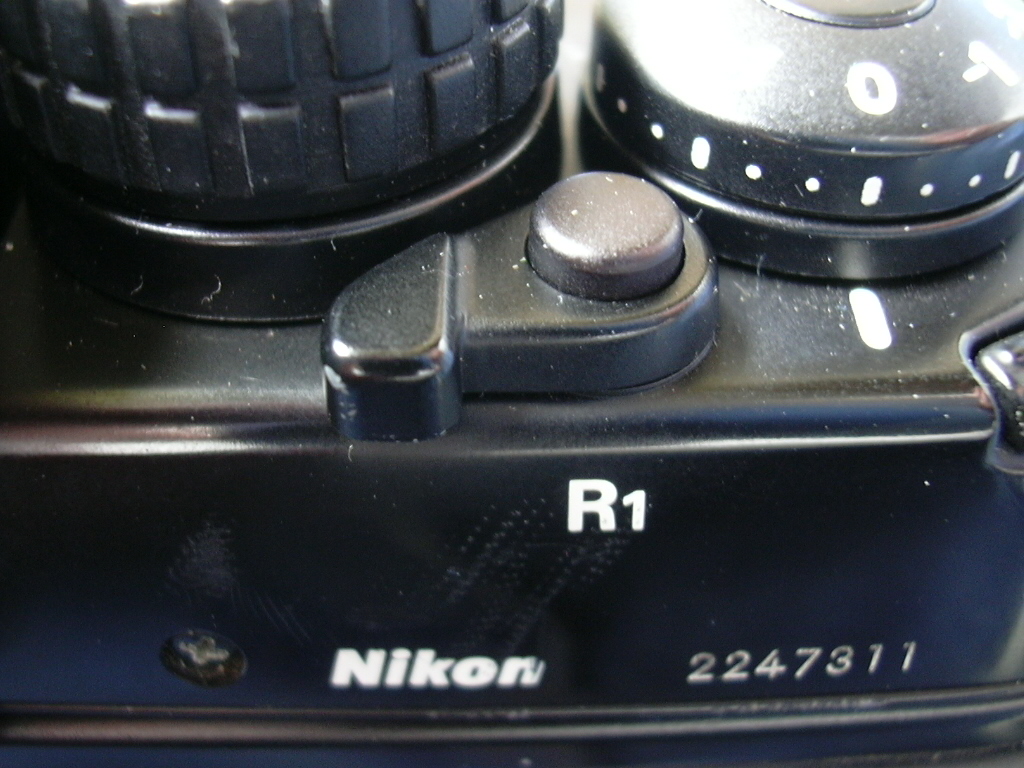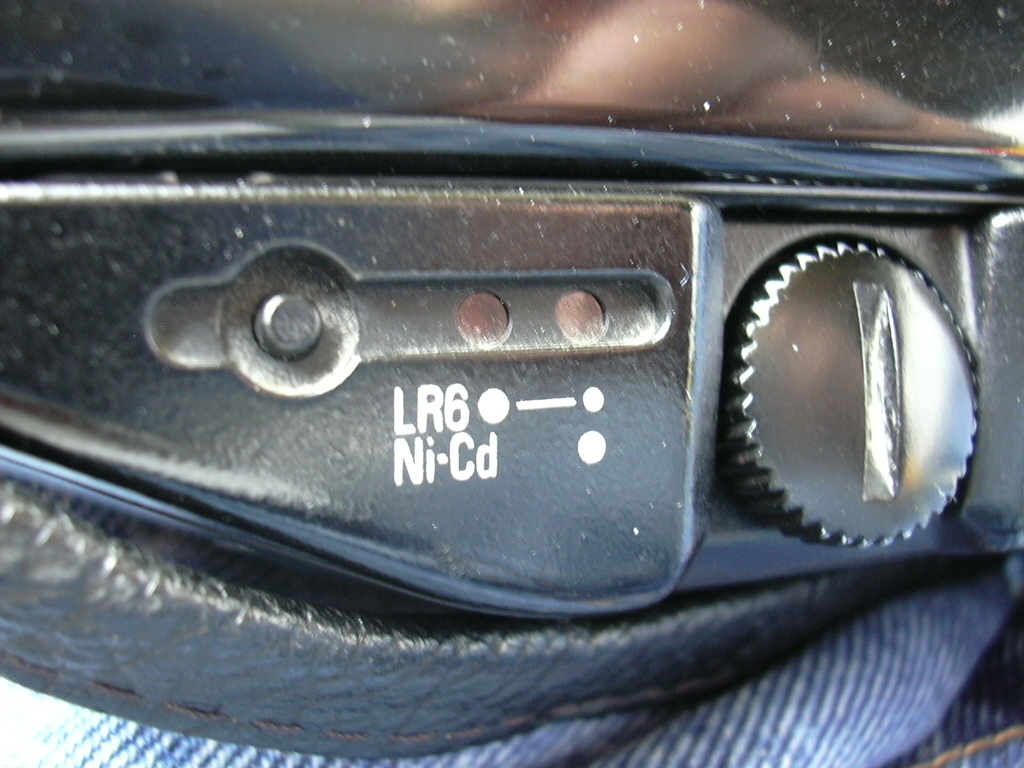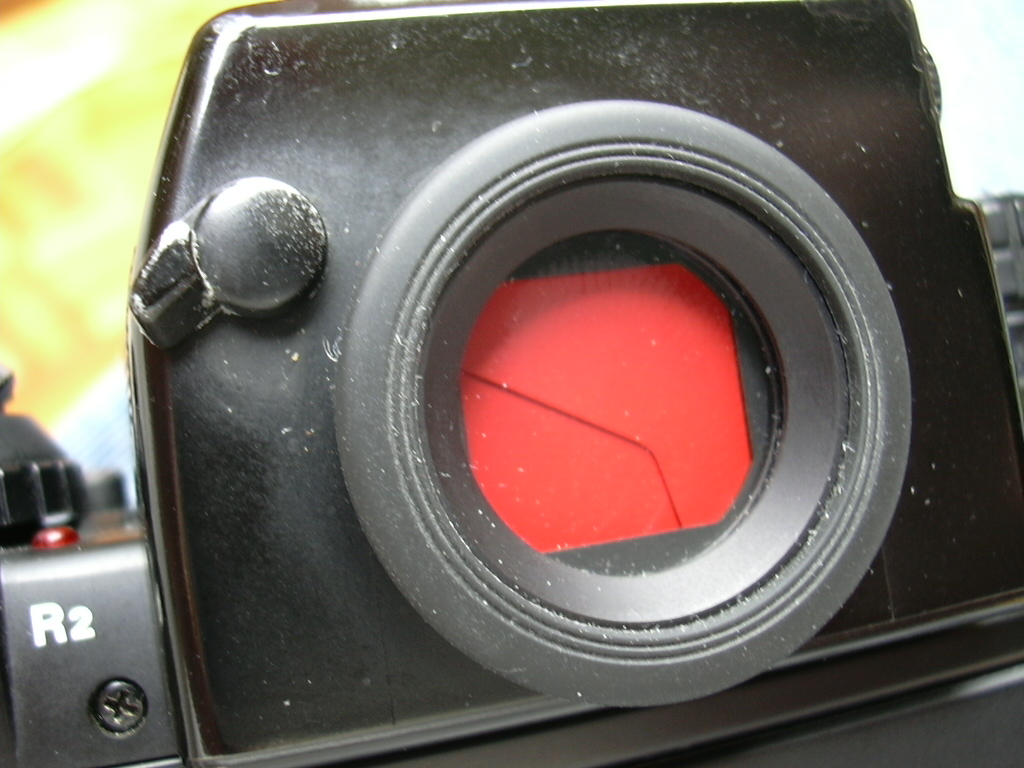Nikon F4
Just 3 years after the introduction of the Nikon F3 Nikon Corporation started to research the possibility of producing a professional single lens reflex camera with built-in motor drive, auto focus system, various exposure programs, high shutter speeds plus high flash synchronization, all packed in a multi-functional and extremely solid body. The famous Italian designer Giugario, who designed e.g. the Nikon F3, EM and others, was consulted and asked to design that camera. In June 1987 the Nikon F4 was taken into commercial production (made up of 1850 parts!). In September 1988 the Nikon F4 and the Nikon F4S were completed and simultaneously introduced in Japan, Europe and in the USA. The Nikon F4E was added in April 1991. Like its three predecessors the Nikon F4 is a camera body that can be ´dressed´ with various viewfinders, backs and power packs. To many photographers this Nikon F4 is the most versatile motorized AF-camera Nikon ever build. All Nikkor lenses, ever built for Nikon SLR´s, can be mounted: from the very first 1959 Nikkor up to the latest AF-Nikkor! The lens mount has an aperture indexing tab that can be lifted, so all older lenses can/will fit. Unfortunately Vibration Reduction is not supported! The camera has a high-speed AM200 AF-module (manual focus, single-servo and continuous AF - including AF-tracking), five exposure-mode programs (Aperture-priority, Shutter-priority, Manual and Program setting). The shutter runs from 4 - 1/8000 sec. and a top flash sync speed of 1/250 sec. It also has TTL flash metering, spot, five-segment matrix or 60 percent center-weighted metering. The viewfinder gives a lot of information about the settings and real situation. Depending on the battery pack in use the motor drive (built-in the standard camera body) can make up to nearly 6 fps. Serial numbers of the body started at 2000001. By the end of 1991 #2230000 was issued; last serial numbers at the end of the last production year (1996) are in the #26xxxxx-range.
Nikon F4(body + DP-20 + MB-20) The basic camera, called Nikon F4, has a handgrip with battery compartment MB-20 (four normal AA-batteries). When using the MB-21 battery pack (6 AA-batteries) the camera is called the Nikon F4s. Fitted with the MB-23 (6 AA-batteries or MN-20 batteries) the camera is called a Nikon F4E. The MB-22 is identical to the MB-21 but needs to be connected to Nikon MA-4 net adapter for use in studios.
Nikon F4s(body + DP-20 + MB-21) The standard viewfinder for all models is the DP-20. It has a built-in viewfinder cover, diopter adjustment, metering selector and ISO hot shoe. This viewfinder can be replaced by a DW-20 waist-level finder, DW-21 waist-level finder with magnifying lens and the DA-20 Sports finder (for those wearing a helmet or glasses). The standard back can be replaced by the basic data back MF-22, the multi-control MF-23 (with sharpness-priority shutter trigger and intervalometer) and the MF-24 for 250-exposure bulk film.
Nikon F4E(body + DP-20 + MB-23)
Below some close-ups of details of the body switches etc.
The large button with the shutter speeds {1/8000 - 4 seconds + B (bulb), T (time) and X (flash)} has been replaced at later models as the white paint went off easily. At the left is the indicator along which the selected shutter speed should be placed. The button/switch at its right is the program selector: Ph (program high), P (program), S (shutter priority), A (aperture priority), M (manual), including the selector for under-/overexposure up to 2 stops. The window on the right shows the frame counter. The button on top right is the shutter release button with a selection of L (Lock), S (single frame), Ch (continuous high speed), Cl (continuous low speed), Cs (continuous silent film transport) and the signal for the self timer. The chrome button on top makes it possible to raise and lock the mirror. The AF-L button is for locking the focused distance with AF-lenses. The lower button (AE-L) is to lock the exposure metering. The chrome button is to release a lens, the button under it is for changing/selecting the auto focus mode: C = continuous focusing (as long as you press the shutter release button), S = single focusing and M = manual focusing. The latter will also retract the auto focus drive stick in the camera mount. On that lens mount you'll see a little chrome latch which can be lifted by pressing the little chrome button next to the white spot. If you use pre-AI-lenses this latch has to be lifted. The chrome tab can be used with all lenses build after 1977. It couples the aperture ring of the lens in use to the exposure meter in the camera. The mentioned white spot is the indicator to mount a Nikkor lens. The covered outlet on top is for connecting a Nikon SB flash light.
These two buttons are placed on the right side of the standard (Nikon DP-20) viewfinder. The left one is to adjust the diopter (-3 - +1) of the viewfinder up to the sight of the user. The large switch is to choose the exposure metering. The white dot is for spot metering, the symbol in the middle indicates the multi-pattern (5 fields) or matrix metering and the right symbol is for center-weighted metering.
This window on the standard (DP-20) viewfinder shows the adjustment possibilities of the exposure meter. When using certain view finder screens the exposure meter has to be adjusted accordingly. Look for more details at the instruction sheet that comes with the relevant screen. The screw driver that will fit into the screw below the window will be supplied with that particular screen too.
On the left top of the camera body one will find under the rewind button the ISO/ASA-selector. The red light is the motorized rewind indicator. R2 indicates the rewind knob and switch which has to be pressed after the R1 switch (see picture below) on the right side of the view finder has been pressed and turned. By doing this the motor drive will rewind film. To save battery power and to avoid a lot of noise this camera has a manual rewind lever as well.
At the back of the battery pack MB-23 it is possible to check the batteries that are in use.
Also the Nikon F4 has the possibility to close the viewfinder to avoid stray light influencing the exposure metering.
Although accepted with some critics, the various models of the Nikon F4 camera became a great success. By the end of 1991, just 3 years after its introduction, 230,000 camera bodies were sold (93,000 in Japan - 137,000 on export markets). Production stopped by the end of 1996 after more than 600,000 cameras. During its ´life´ some minor changes on the camera body took place, like a better paint on the knobs and buttons. It has been proved to be a very reliable camera and may still be used as a back-up camera. As stated all Nikkor lenses Nikon ever built may fit (although VR wont work) and it uses normal AA-batteries, available all over the world. The fact that it uses batteries - however - may be the only negative point. The camera has no mechanical shutter release (like the Nikon F3 has). if you find a second hand F4 check it carefully. Prefer to find a camera with serial number 25xxxxx or higher. These are the last models with all modifications Nikon has released. Parts, backs and battery packs are easy to find on secondhand markets.
|

